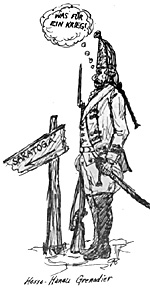 If Friedrich August of Anhalt-Zerbet was the most eccentric German prince to lease troops to the English during the Revolution, count Wilhelm of Hesse-Hanau was certainly the most obnoxious. Crude, avaricious, and opportunistic, he stood out as a villainous man in a villianous age.
If Friedrich August of Anhalt-Zerbet was the most eccentric German prince to lease troops to the English during the Revolution, count Wilhelm of Hesse-Hanau was certainly the most obnoxious. Crude, avaricious, and opportunistic, he stood out as a villainous man in a villianous age.
Due to a series of domestic quarrels, Wilhelm, although heir to the Lans-Grave of Hesse-Cassal, he lived with his mother, the arranged English wife of the Land grave, in the independent County of Hanau. On the death of his father in 1785, he succeeded him. An ally of Austria, he later fled his dominions during the Napoleonic Wars, and Hesse-Cassel was incorporated into Jerome Bonapart's Kingdom of Westphalia, and Wilhelm led a life of affluent luxury until Napoleon came a cropper in his Russian campaign. Through his troop deals and other financial coups, Wilhelm had be one one of Europe's richest men.
An interesting footnote to his career is the fact that he gave to the famous Rothschild family its first break in international banking, little suspecting what he was starting! At the time Mayor Rothschild was a curio dealer and moneylender dwelling in the Frankfort Ghetto. In a few decades, the House of Rothschild, under Meyer's sons, could command sums that would have made old Wilhelm shudder.
But to return to the Revolution, Wilhelm furnished the British an estimated 2,422 men. They made up the following units (including later recruitments to keep up strength):
The Erb-Prinz Musketeer Regiment under Colonel von Gall (1 grenadier and five musketeer companies).
The Hesse-Hanua Jager Corps (4 companies a under Lt. Col. von Creutzbourg, uniform described in a previous article in this series.)
The Hanau Artillery Corps (120 men under a respected veteran, Captain Georg Paunch, originally raised as part of the Erb prinz regiment due to the small size of the Hanau army.
The Hesse-Hanua Freikorps (while most of the above men served in Canada and on the unsuccessful Burgoyne expedition, this unit was a later development, an all-volunteer outfit of light troops consisting of one rifle company and four infantry companies with a total strength of 830 officers and men. It served with the main British forces in the central colonies.
UNIFORM OF THE ERB PRINZ REGIMENT
Blue coats faced in red. Lace white, in the form of an 8" (horizontal) at each of the six lapel buttons and two buttonholes below the lapels. Musketeers wore a black tricorn white-scalloped border and black cockade. Pompons were white with red. The grenadier helmet is the subject of some controversy. Colonel Larter and others claim that the cloth sack behind the front shield was yellow with white trim. The most authoritative German sources, however, seen to agree that the color wasn't yellow but rarer red. The front shield, with motif, was of-white metal, an were uniform buttons. The vests were yellow and the authorities disagree on whether the breeches were also yellow, or buff or white instead. Gaiters were black. Neckstooks were black and leather belting was white--the same applies to the scalloping on hats.
The accompanying illustration gives an idea of the general cut of the Erbprinz uniform (warning there was also a Hesse-Kassel Erbprinze regiment) which generally conformed to the Prussian pattern of the 1760's-80's. The ornate regimental lace makes it a slightly more colorful unit than most of the Hessians and Brunswickers, and it served without dishonor, although later in the war one comes across some uncomplimentary references to Colonel von Gall in the correspondence of Baron von Riedesel, Burgoin's senior German officer.
The next installment, space and time permitting, will discuss the balance of the Hesse-Hanau contingent, with special attention given to the artillery company, a unit that earned high marks even, in the midst of defeat, and was commanded by an admirable career officer.
Back to The Armchair General Vol. 2 No. 6 Table of Contents
Back to The Armchair General List of Issues
Back to MagWeb Master Magazine List
© Copyright 1970 by Pat Condray
This article appears in MagWeb (Magazine Web) on the Internet World Wide Web. Other military history articles and gaming articles are available at http://www.magweb.com
